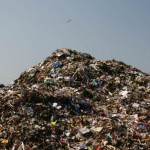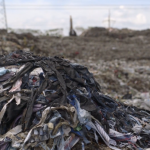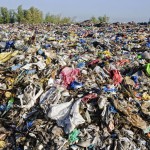It was probably about a year ago that I passed by my friend while she was making a rug out of old clothes, when I asked her why, she explained to me that there is an overabundance of textiles in the world. She told me about how this is actually starting to become a problem, so she was trying to find a new purpose for left over textiles or old clothes. (Re-purposing textiles is an old technique but maybe growing into necessity.) The overabundance of textiles was an issue that never really occurred to me before but immediately caught my attention because it’s so obvious if you think about it.
The attitude that people have towards clothing has changed, fashion trends move quick, every year there are new collections from every brand, stores are filled monthly, or even weekly and we all buy into it. The average person buys 60% more garments that last half a year compared to fifteen years ago. The way of production has changed as well, the materials are cheaper and made not to last very long. Next to that the production has inflated massively, according to Greenpeace the production has doubled from the year 2000 to 2014 and the number of garments exceeded 100 billion by 2014. A lot of clothes that are being made don’t even make it to the shops, they were made to have enough in stock even though the shops are often overstocked already. The clothes that don’t sell fast go into sale, but 4,2% stays behind after the sale. That doesn’t sound like much but we’re talking about 21,5 million new pieces of clothing, from which 12,3 million pieces get destroyed. They get burned in ovens or shredded because the clothing companies don’t want these clothes to be used or resold.
Next to the overproduction of the fashion industry, we have our fair share of throwing away textiles as well, the average person throws away about thirty kilos of clothing per year, this is roughly eight trash bags a year, even though 95% of the clothes we chug away is still reusable. Not only the clothes that get thrown away cause problems but donation in some cases as well. The clothes that are donated to charity and can’t get sold in charity shops are shipped off to third world countries. In some of those countries, here it gets sold for so cheap that the local tailors can’t compete anymore and have to go out of business
The waste that the left over and thrown away textile produce is polluting the environment and is practically toxic waste. Since the clothes are produced so cheaply the fabrics are often synthetic and the dyes are toxic. The clothes that get burned release a lot of chemicals in the air. The clothes that get thrown away often end up in landfills. Since they’re not biodegradable they just keep staggering up, causing an environmental hazard. The textiles chemicals and toxins get absorbed by the soil, polluting both the surface and the ground water. It also releases methane into the air which contributes to global warming.
So now what do we do? What can we do about this? There might be a few options. One of them is instead of throwing away the old clothes that we’re sick of, or never wear anymore, remake them into something new. This is what for example Viktor and Rolf did for the Boulevard of Broken Dreams collection of 2017. They used pieces and materials of left over material, pieces and damaged items of previous collections. Italian company Marchi & Fildi turns old fabrics, in this case pre-dyed cotton textile scraps that are left over in the fashion companies to make a new recycled yarn, Ecotech. But also the company Evrnu found a way to turn cotton waste into a new fiber, by first turning it into a pulp. With these approaches cotton waste is being saved and a new durable material is created for fashion designers to work with.
I noticed that after doing more research on how polluting the fashion industry actually is, it changed the way I look at certain things, I started experimenting with making new clothes out of the ones I didn’t want anymore and working with the small pieces that get leftover in the process (inspired by for example the Japanese Boro technique). It saves quite some money to buy less and think responsibly about the clothes you don’t want. Instead of just throwing it in the bin, bringing it to secondhand shops or even selling it is way more profitable for yourself and the environment. This problem is so severe and almost everyone contributes to it without even thinking. The fashion industry is now the second most polluting industry in the world, right after the oil industry. So I hope you will remember this information the next time you’re doubting whether or not to buy that shirt so we can all take small steps towards a solution for this waste of fashion.




